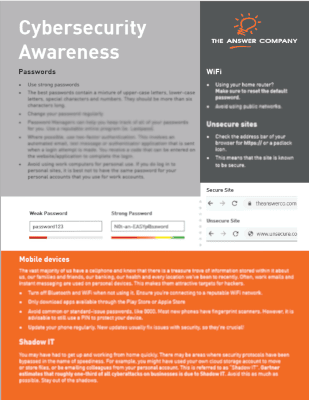Governments across the world have issued strong advisories that anyone who can work from home should work from home and remote working could become the norm, post-COVID-19. As a company, this presents many challenges, some of which are incredibly important and urgent right now – from keeping your employees engaged to ensuring your people are safe and your systems stay secure.
The Answer Company is here to support your business continuity from obsolete technology or business processes or solve any issues. Get in touch with our team to let us know how we can best support you. We are available via phone, email and website chat.
Below you’ll find tips on how to safely transition your team to ensure business continuity. We’ll continue to provide updates on best practices and resources as we get them.
The transition to enabling a remote workforce normally requires a long term plan. Many small businesses did not anticipate this need and the scramble to get their staff access has left some businesses at risk for cyber-attacks. For businesses with limited IT resources, working with a Managed Service Provider (MSP) will help ensure your systems are more resilient to cyber threats.
To learn how Managed IT Services can ensure that your systems are always running smoothly, check out this great PDF.
While not exhaustive, review the items below to help minimize system vulnerabilities:
- Use Virtual Private Networks (VPNs) to provide remote employees with a secure channel to business systems;
- Enable multi-factor authentication for VPN and critical information systems;
- Consider moving on-premise servers and applications to the cloud. The anywhere-anytime nature of cloud solutions means that they can save your employees from having to travel to your offices to maintain and monitor servers or storage solutions you’re using;
- Monitor, measure and record network data meticulously. It is a good time to invest in threat-detection upgrades;
- Update Antivirus/Anti-malware programs on all computers accessing the network;
- Define restrictions on the data that can, and cannot, traverse the VPN. For example, very sensitive data may be more securely transferred by voice call;
- Instate backup and disaster recovery (BDR) plans.
- Double-check that backups are working properly and stored securely off the network; and
- Ensure staff are not using personal devices to access the network.
Employee Cybersecurity Awareness TrainingEnsuring both connectivity and safety is much more complex than having a centralized office when there are more points of entry for malicious players. The weakest link in any organization, in regards to security, are the users. On rare occasions, staff purposefully engage in malicious activities. More often than not, users unknowingly infect their computers. The best way to mitigate this is through an active campaign to empower their staff with knowledge of best practices. We’ve developed a handy desk-side resource for employees. It gives some information on cyber attacks and offers tips on how to maintain high security standards from home. |
 |
